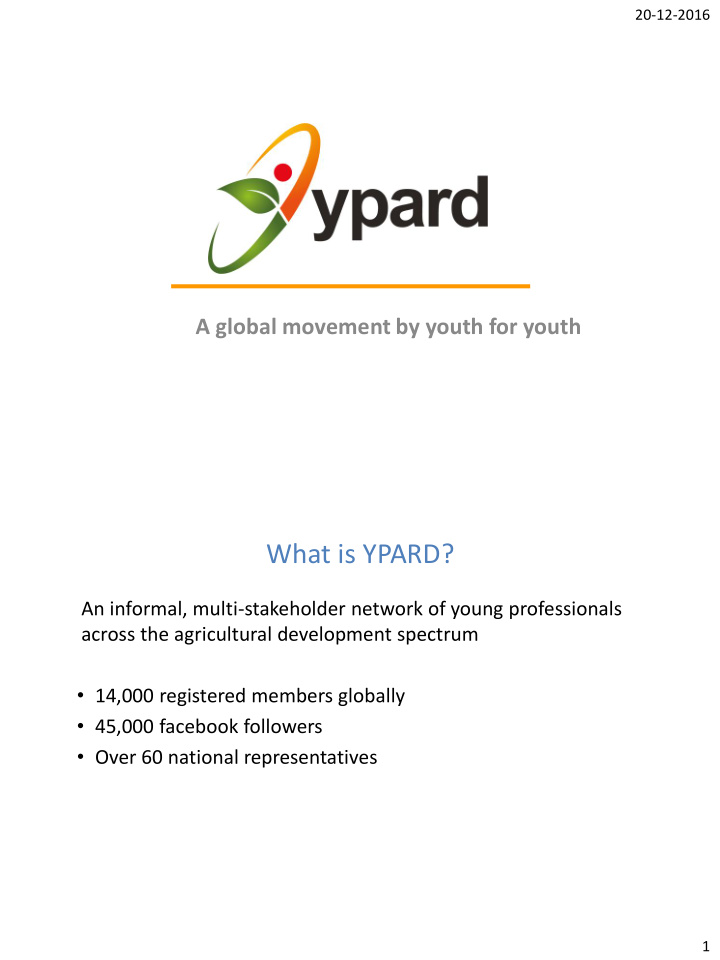



20-12-2016 A global movement by youth for youth What is YPARD? An informal, multi-stakeholder network of young professionals across the agricultural development spectrum • 14,000 registered members globally • 45,000 facebook followers • Over 60 national representatives 1
20-12-2016 Structure Global Coordination Unit at at at at at Mentoring • Rural youth have less access to capacity development and mentoring • 90 % of YPARD members expressed interest in mentoring • So how can mentoring be a tool to bring about transformational change among young people; to develop successful young entrepreneurs, researchers and development practitioners that would become successful role models for young people around the world? 2
20-12-2016 YPARD Pilot Mentoring program • Desk-review (late 2014) and piloting of different forms of mentoring (early 2015): trialed peer mentoring linked to seed funding, face to face, purely online, and conference mentoring. • National spin offs, notably in Nepal and Croatia, with changes suited to local context; Esther and Nicholas (peer to peer in Kenya) • After the training Esther convinced her family to give her some land for tomatoes and lettuce; • She built a greenhouse and has four part-time employees; • She is now mentoring others in the community • Neighbours now replicating her methods. Esther believes that Nicholas has been instrumental in helping her overcome challenges: “Consistent communication with my mentor has played a very big role in success of my farming. This being my first greenhouse it had a lot of challenges which, if I had no advice from my mentor, I probably would have given up along the way.” Nicholas has seen a major cultural change in Esther’s community, observing that many neighbouring farmers had watched Esther’s success and were replicating her methods. “I was able to help convince Esther’s parents to give her land in a highly male centric community. Explaining YPARD and its vision to the parents helped them to have a light bulb moment and they finally said they would support her all the way.” 3
20-12-2016 Main achievements In 12 months, mentees: • Secured US$ 27,000 approx in grants and gov loans. • Two full international PhD scholarships • Trained over 1000 farmers and other youth by mentees and mentors. Mentees became mentors. • 5 businesses started, 7 businesses expanded • 2 jobs/internships • Changes in gender norms/attitude on role of youth in agriculture • Improvement in confidence, networking and soft skills Mentoring review • Scale is small and it is resource intensive • Young people 1.7 times more likely to fail in entrepreneurial undertakings Caution, but… • Very strong early impact • Potential to support individuals who are committed to innovation • Potential to support projects with broader social impacts • Tailoring mentoring programs using a mix of methods 4
20-12-2016 Recommendations • 1. Face to face meetings enhance mentoring relationships and require investment • 2. Relationships must have an anchor/focus but this must be flexible (goals, map how to achieve goals, but too focused, maybe mentee has other needs) • 3. Take steps to address time poverty • 4. Help mentees ask for help (sometimes to shy to ask for help) • 5. Set a nurturing, patient and supportive group culture in all projects, to avoid competitiveness • 6. Training and checking in with pairs/groups is crucial • 7. Mentees need access to funding and practical opportunities • 8. Future program management and coordination is decentralised • 9. Expand M&E design to capture longer term lessons and successes • 10. Operate from a more comprehensive and realistic budget Insights on Mentoring (Plan International) • The importance of transferable skills (or soft skills and life skills) is equally important to technical skills for their career path • Integrated approach: Mentorship alone is not enough, need for setting up financing mechanisms to accompany young graduates/entrepreneurs as well as post-training support. • Involvement of stakeholders from private sector as mentors, but do not underestimate investment in engaging with the private sector 5
More recommend